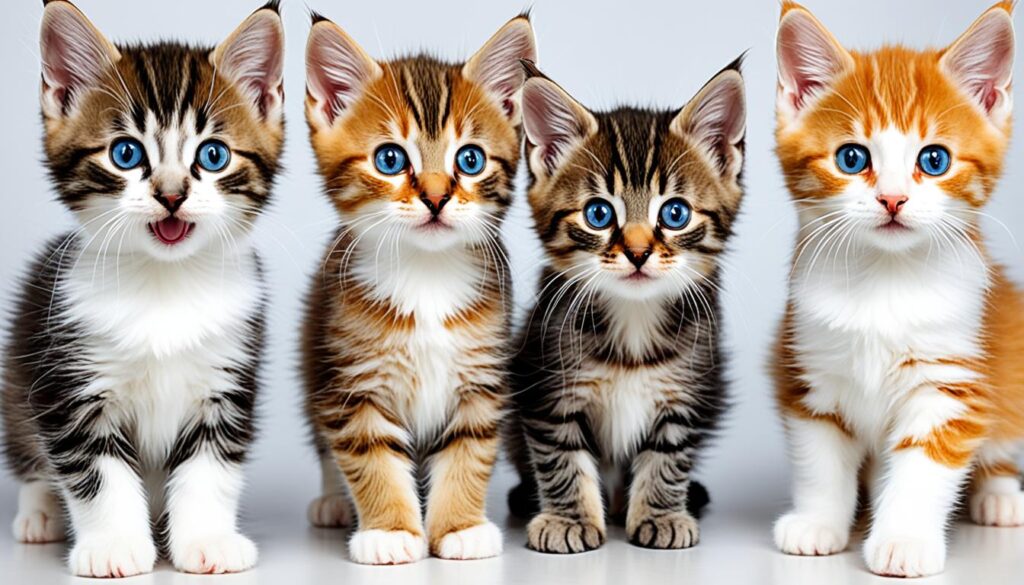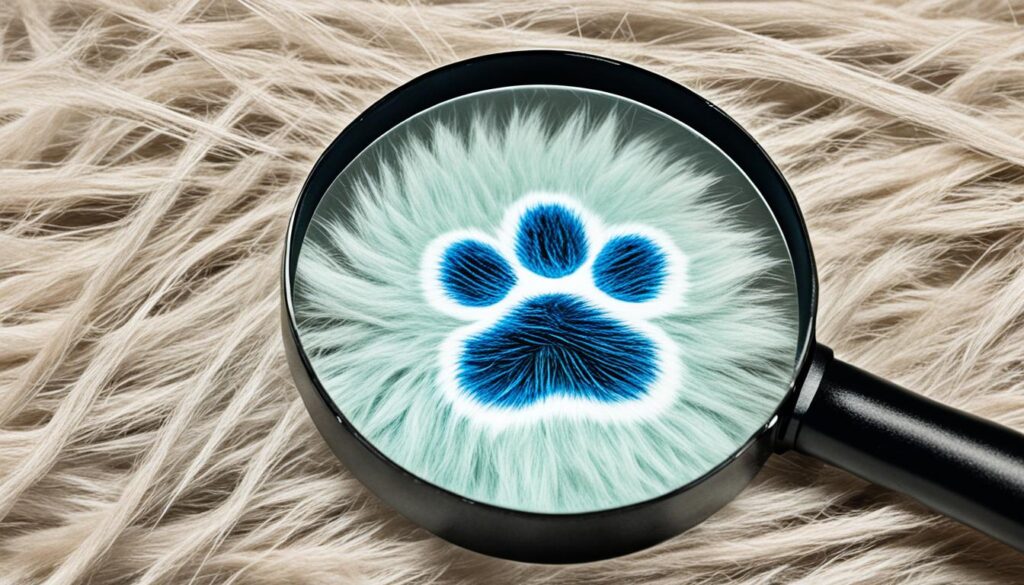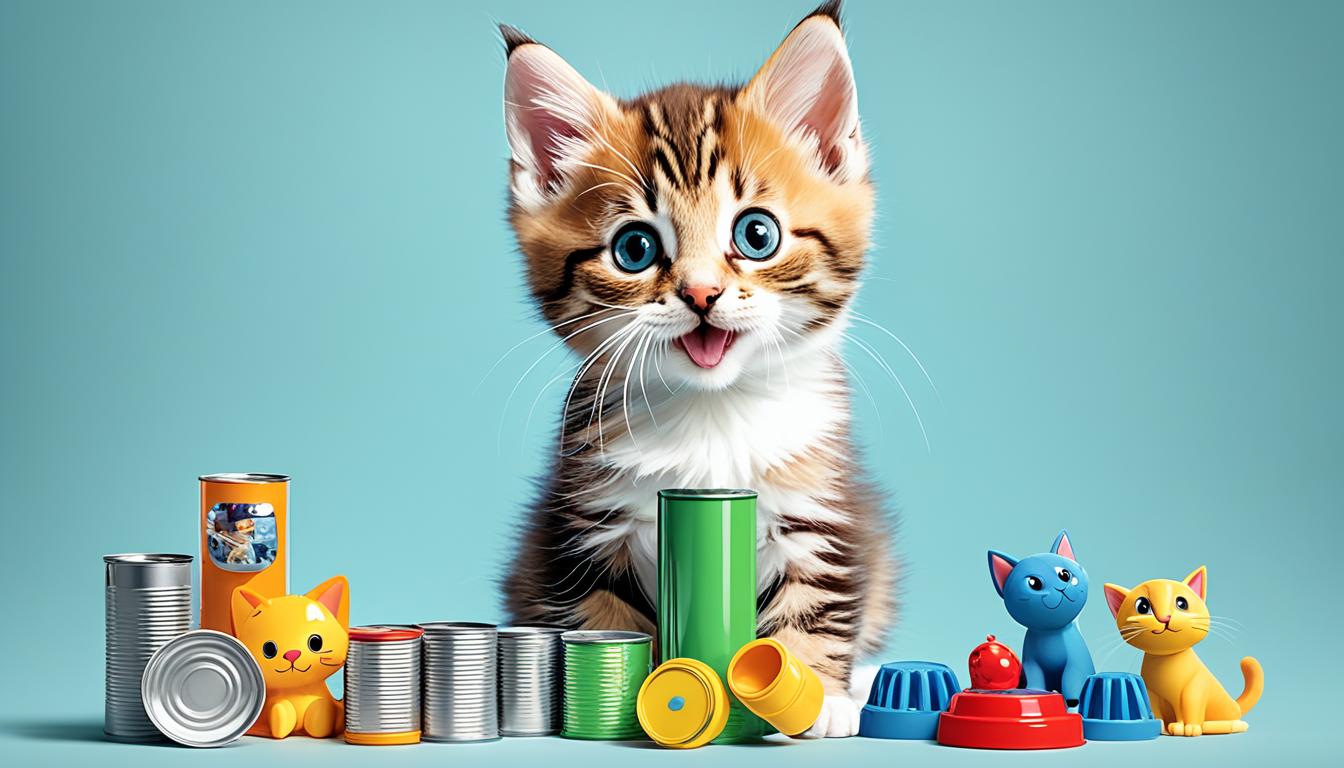As an Amazon Associate I earn from qualifying purchases.
Have you ever found yourself gazing into those innocent, wide eyes of your adorable furball, wondering how old they really are? It’s a question that plagues many pet parents, causing a mix of curiosity and concern. After all, knowing the age of your kitten plays a crucial role in providing them with the appropriate care and understanding their developmental milestones.
But fret not! We have a purrfect solution for you – our Kitten Age Quiz. This interactive quiz combines fun and education as you answer a few simple questions about your furball to make an educated guess about their birthday. No more scratching your head in confusion or resorting to wild speculations. Take the quiz and unlock the fascinating mystery of your kitten’s age!
Key Takeaways:
- Guessing a kitten’s age can be challenging, but our Kitten Age Quiz can help make it fun and educational.
- Answer a few questions about your kitten to make an educated guess about their birthday.
- Knowing your kitten’s age is essential for providing appropriate care and understanding their developmental milestones.
- Stop wondering and take the quiz to discover the age of your beloved furball!
Kitten Growth Stages: Understanding the Development Timeline
Kittens are like tiny, adorable whirlwinds of fur and energy. But did you know that they go through different growth stages as they develop? These stages are essential for estimating their age and understanding their overall development. Let’s dive into the fascinating journey of a kitten’s growth and discover the milestones they reach along the way.
Stage 1: The Helpless Newborn
At the beginning of their lives, kittens are completely dependent on their mother. They are born blind and deaf, relying on their sense of touch and smell to find their mother’s warmth and nourishment. During this stage, kittens spend most of their time sleeping, cuddling with their littermates, and nursing.
Stage 2: The Curious Explorers
As kittens grow, they become more curious about their surroundings and start venturing out to explore. Their natural curiosity drives them to investigate every nook and cranny, often getting themselves into adorable mischief along the way. You might notice them pouncing on toys, play-fighting with their littermates, and attempting their first leaps and bounds.
Stage 3: The Playful Learners
During this stage, kittens continue to refine their motor skills and develop their coordination. They become experts at chasing moving objects, batting at toys, and practicing their acrobatic jumps. Playtime becomes an essential part of their day as they learn valuable skills for hunting and survival.
Stage 4: The Growing Independence
By this stage, kittens are becoming more independent and self-reliant. They start weaning off their mother’s milk and transitioning to solid food. Their baby teeth are replaced by adult teeth, enabling them to gnaw and chew on different textures. They become more interested in interacting with humans and seek attention and affection.
Understanding these growth stages and observing your kitten’s behavior, size, and physical development can provide valuable insights into their age. Keep in mind that the timeline of development may vary for each individual kitten, but these stages serve as a general guideline.
Take a look at this adorable image of a kitten in various growth stages:
Now that you have a better understanding of kitten growth stages, you’ll be better equipped to estimate their age and appreciate each precious moment of their development. Stay tuned for more insights on determining kitten age and the cues to look for!
Physical Cues: Clues to Determining Kitten Age
When it comes to determining a kitten’s age, physical cues can provide invaluable clues. By observing their teeth, eyes, and body proportions, you can gain insight into how old they might be. Let’s take a closer look at the physical cues that can help you guess your kitten’s age.
Teeth: Tiny Indicators of Age
Just like human babies, kittens go through teething stages that can give you an idea of their age. By examining their teeth, you can make an educated guess about their growth progress. For example, the presence of baby teeth indicates a younger kitten, while the emergence of adult teeth suggests they are older.
Eyes: Windows to Their Age
Kittens are born with closed eyes, but as they grow, their eyes begin to open at different stages of development. The timing of eye opening can provide valuable insights into their age. Younger kittens typically have closed or partially open eyes, while older kittens have fully open eyes, allowing them to explore the world around them with wonder.
Body Proportions: Clues in Size and Weight
The size and weight of a kitten can be a reliable indicator of their age. Newborn kittens are tiny and fragile, weighing only a few ounces, while older kittens are more robust and have more substantial body proportions. Comparing your kitten’s size and weight to a cat age calculator can help you estimate their age more accurately.

“Physical cues, such as teeth, eyes, and body proportions, can be invaluable in determining a kitten’s age. Take a closer look at these indicators to make an educated guess about your furball’s birthday!”
By paying attention to these physical cues, you can become a Sherlock Holmes of kitten age estimation. Remember that every kitten is unique, and their development may vary. Use these clues as a starting point, and embrace the journey of discovering your furry friend’s age.
| Physical Cues | Indicators |
|---|---|
| Teeth | Baby teeth vs. adult teeth |
| Eyes | Closed, partially open, or fully open |
| Body Proportions | Size and weight compared to cat age calculator |
Coat Changes: A Sign of Aging
When it comes to determining a kitten’s age, their coat can provide valuable clues. As kittens grow older, their fur goes through changes in color, texture, and pattern, offering insights into their age.
Some kittens are born with fluffy coats that later evolve into sleek and short-haired fur. Others develop distinct markings or patterns as they age. By observing these coat changes, you can make an educated guess about the age of a kitten.
It’s fascinating to witness how a kitten’s coat transforms over time, and it’s an essential part of their journey to adulthood. Here’s a closer look at the coat changes that can help you determine your furball’s age:
Color Evolution
- Tabby Kittens: Tabby kittens often have lighter coats as they start their journey. With age, their fur darkens, and the iconic tabby patterns become more prominent.
- Black Kittens: Black kittens may have a slight brownish tint in their coat when they are young. As they grow, their fur usually becomes a solid and intense black color.
- Calico and Tortoiseshell Kittens: Calico and tortoiseshell kittens often have more muted colors when they are born. As they age, their fur brightens, and the distinctive patches become more defined.
Texture Transformation
Not only does a kitten’s coat change in color, but it also undergoes texture transformations as they mature. Here are some examples:
- Fluffy to Sleek: Some kittens are born with fluffy coats, resembling little puffballs. As they grow, their fur becomes denser and sleeker, usually indicating that they are maturing.
- Long Hair to Short Hair: Certain breeds start with longer fur but gradually develop shorter hair as they age. This transition typically occurs during the kitten’s first year.
Quote:
“A kitten’s coat changes are like nature’s way of leaving pawprints on the timeline of their growth.” – Cat Lover Magazine
By paying attention to these coat changes, you can gain valuable insights into your kitten’s age and development. Keep in mind that every kitten is unique, and individual variations may exist. The coat is just one puzzle piece, but when combined with other physical cues and observations, it can help you determine your furball’s age with more confidence.

Kitten Coat Changes
| Coat Type | Changes Over Time |
|---|---|
| Tabby Kittens | Lighter fur as kittens, darkening with age, more prominent tabby patterns |
| Black Kittens | Brownish tint when young, solid and intense black fur as they grow |
| Calico and Tortoiseshell Kittens | Muted colors when born, brightening with age, more defined patches |
| Fluffy to Sleek | Puffy and fluffy coat as kittens, denser and sleeker fur as they mature |
| Long Hair to Short Hair | Starting with longer fur, transitioning to shorter hair during the first year |
Interaction and Socialization: A Window into Age
When it comes to estimating the age of a kitten, their interaction and socialization skills can serve as valuable clues. By observing their behavior with humans and other animals, you can gain insights into their developmental stage. Let’s dive into how their social skills evolve as they grow!
Timid Beginnings
Very young kittens, often in their early weeks of life, may exhibit timid behavior. They may rely heavily on their mother for comfort and protection, shying away from unfamiliar faces and situations. These little furballs are just starting to explore the world, cautious with every step.
The Curious Phase
As kittens grow older, their curiosity blooms, and they become more interactive. They eagerly approach new objects, pounce on toys, and playfully chase anything that moves. This inquisitive behavior indicates their progression from the earliest stages of kittenhood. At this point, you’ll witness their budding personality shine through!
Playful and Independent
As kittens continue to age, their playfulness and independence blossom. They engage in energetic play sessions, chasing and climbing with agility. Their socialization extends beyond their mother, and they seek interaction with both humans and other animals. This stage is a true testament to their growth and development, showcasing the blossoming of their unique individuality.
So, remember, as you observe your kitten’s interactions and socialization skills, you can make an educated guess about their age. From timid beginnings to curious exploration and playful independence, each stage offers glimpses into their developmental journey.
| Age | Interaction and Socialization Behaviors |
|---|---|
| 0-4 weeks | Reliant on mother for comfort and protection, timid around humans and other animals |
| 4-8 weeks | Becoming more curious, playfully exploring their surroundings, limited but increasing socialization with humans and littermates |
| 8-12 weeks | Highly interactive, seeking companionship with humans and other animals, energetic play sessions, developing individual personality |
Veterinary Assessment: Professional Help in Determining Age
If you’re still unsure about your kitten’s age, a veterinarian can provide professional assistance. They have the experience and expertise to assess a kitten’s physical characteristics, teeth, and overall development to determine their age more accurately. A vet can also guide you on the appropriate care and nutrition based on the estimated age of your kitten.
Having a professional vet assess your kitten’s age can provide valuable insights and ensure that you are providing the best possible care. They will examine your kitten’s teeth, which can be a strong indicator of age progression. Just like humans, kittens lose their baby teeth and develop adult teeth as they grow. The presence or absence of certain teeth can help determine their age range. Additionally, a vet will examine your kitten’s physical characteristics, such as size, weight, and body proportions, to estimate their age based on established parameters.
“A veterinarian’s expertise in assessing a kitten’s age can make a significant difference in tailoring their care and meeting their unique needs. From choosing the right diet to planning a suitable vaccination schedule, their professional guidance is invaluable.”
Furthermore, a veterinarian can evaluate your kitten’s overall development and compare it to typical growth milestones. This assessment considers aspects like coordination, mobility, and social behavior. By observing how your kitten interacts with their environment and other animals, the vet can gauge their age and determine whether they are meeting developmental expectations.
Once the veterinarian has determined your kitten’s age, they can offer tailored advice on nutrition, exercise, and healthcare. This includes guidance on vaccinations, spaying or neutering, and preventive measures against common health issues. Their expertise ensures that you are providing the necessary care and setting your kitten up for a healthy and happy life.
Resources and References for Determining Kitten Age
When it comes to determining your kitten’s age, you don’t have to rely solely on guesswork. There are various resources and references available that can assist you in estimating how old your furry friend is. From cat age calculators to kitten age charts, these tools can be valuable assets in your journey to uncover your furball’s age.
One popular resource is the cat age calculator, which uses a combination of weight and age-related factors to provide an estimate of your kitten’s age. By inputting your kitten’s weight and comparing it to the provided benchmarks, you can get a sense of their approximate age stage. Keep in mind that these calculators provide general estimates and may not be 100% accurate due to individual variations.
Another helpful reference is the kitten age chart. These charts outline the typical physical and behavioral milestones that kittens reach as they grow. By comparing your kitten’s characteristics to the chart, such as the development of their teeth, eyes, and physical milestones, you can make an educated guess about their age. Remember, these charts serve as general guidelines, and every kitten may progress at their own pace.
In addition to online tools and charts, there are plenty of informative online guides available that dive deeper into the intricacies of estimating kitten age. These guides offer detailed explanations, tips, and visuals to help you identify the unique characteristics and changes in a kitten’s appearance as they age. Some even provide step-by-step instructions on how to perform physical examinations to determine age more accurately.
“The cat age calculator and kitten age chart can be excellent starting points for estimating your kitten’s age. Remember to consider multiple factors, observe their behavior, and consult with a veterinarian for a professional evaluation.”
Kitten Age Chart Example
| Age Range | Physical Characteristics | Behavioral Milestones |
|---|---|---|
| Newborn | Unable to open eyes, ears folded, umbilical cord attached | Mostly sleeping, feeding on mother’s milk |
| 1-2 weeks | Eyes begin to open, ears unfolding, starting to crawl | Slightly more active, trying to walk |
| 3-4 weeks | Eyes fully open, ears erect, starting to develop baby teeth | Becoming more independent, starting to explore surroundings |
| 5-6 weeks | Baby teeth fully developed, starting to wean off milk | Increased playfulness, socializing with littermates |
| 7-8 weeks | Adult teeth eruption, coat becoming denser | Exploring and playing more actively |
| 9-10 weeks | Adult teeth fully formed, coat maturing | Developing feline behaviors, pouncing and stalking |
| 11-12 weeks | Coat reaching its adult length, steady growth | High-energy play, beginning to test boundaries |
While these resources can provide valuable insights into estimating your kitten’s age, it’s important to remember that they are not definitive. Kittens can mature at their own pace, and individual variations can make age determination challenging. Consulting with a veterinarian is still recommended for a professional evaluation and accurate assessment of your kitten’s age.
Conclusion
Determining the age of your kitten can be a delightful adventure filled with playful curiosity and heartwarming moments. While it may not be an exact science, there are several clues that can guide you in estimating their age accurately. By considering their physical cues, coat changes, interactions, and seeking professional veterinary advice, you can make an educated guess.
Remember, every kitten is a unique little individual, and their development may vary. So, embrace this journey of discovery and revel in the joy of getting to know your furball’s age. Whether they are a tiny ball of fluff or a mischievous bundle of energy, cherish these precious moments as you bond with your feline friend.
So go ahead, use your detective skills and let your intuition shine! The subtle hints your kitten gives you, combined with the information you gather from observing their growth and seeking expert advice, will help you unlock the mystery of their age. Enjoy this exciting chapter of your kitten’s life, and may your bond grow stronger with each passing day!
FAQ
How can I determine the age of my kitten?
What are the growth stages of a kitten?
How can I estimate my kitten’s age using physical cues?
Can changes in a kitten’s coat indicate their age?
How can I use interaction and socialization to determine a kitten’s age?
Should I seek professional veterinary assistance to determine my kitten’s age?
Are there resources and references available to help determine a kitten’s age?
What is the importance of determining a kitten’s age?
Source Links
- https://dailykitten.com/chat/topic/happy-birthday-jeankit-4/
- https://core-docs.s3.amazonaws.com/documents/asset/uploaded_file/1427540/ARList.pdf
As an Amazon Associate I earn from qualifying purchases.

